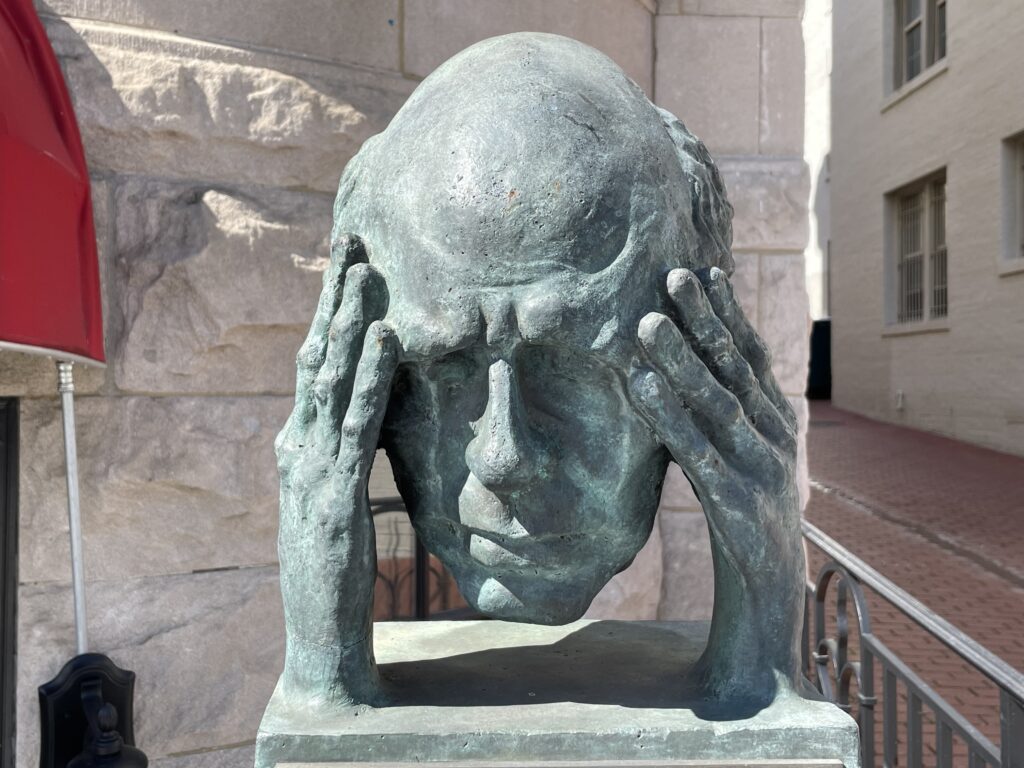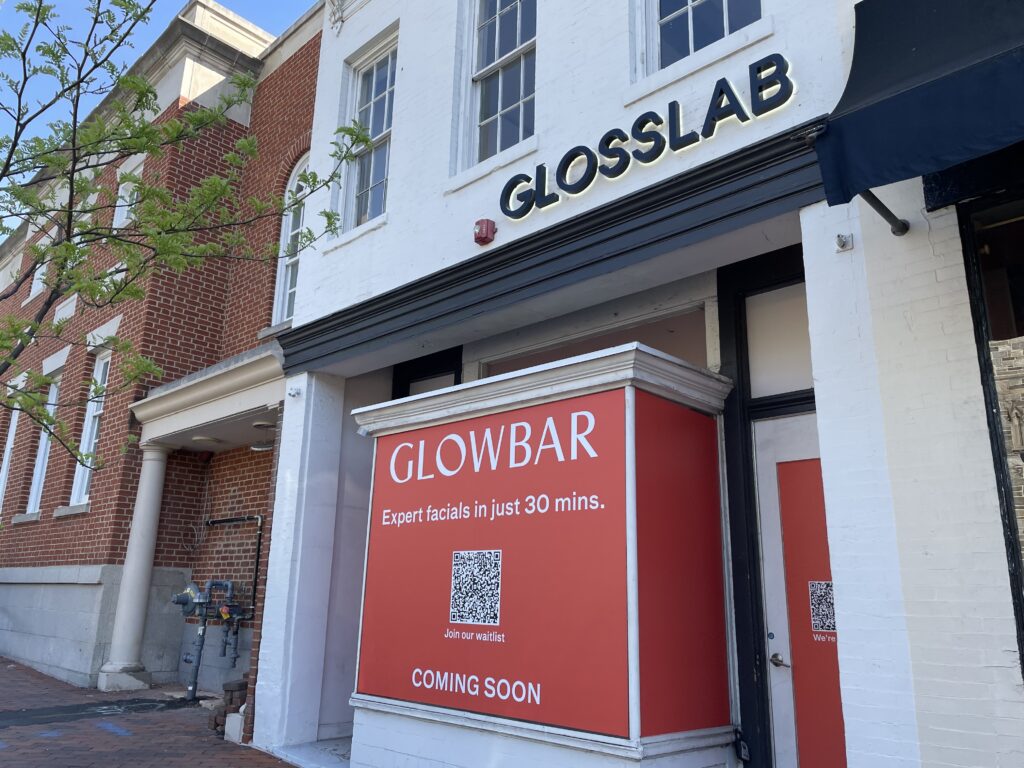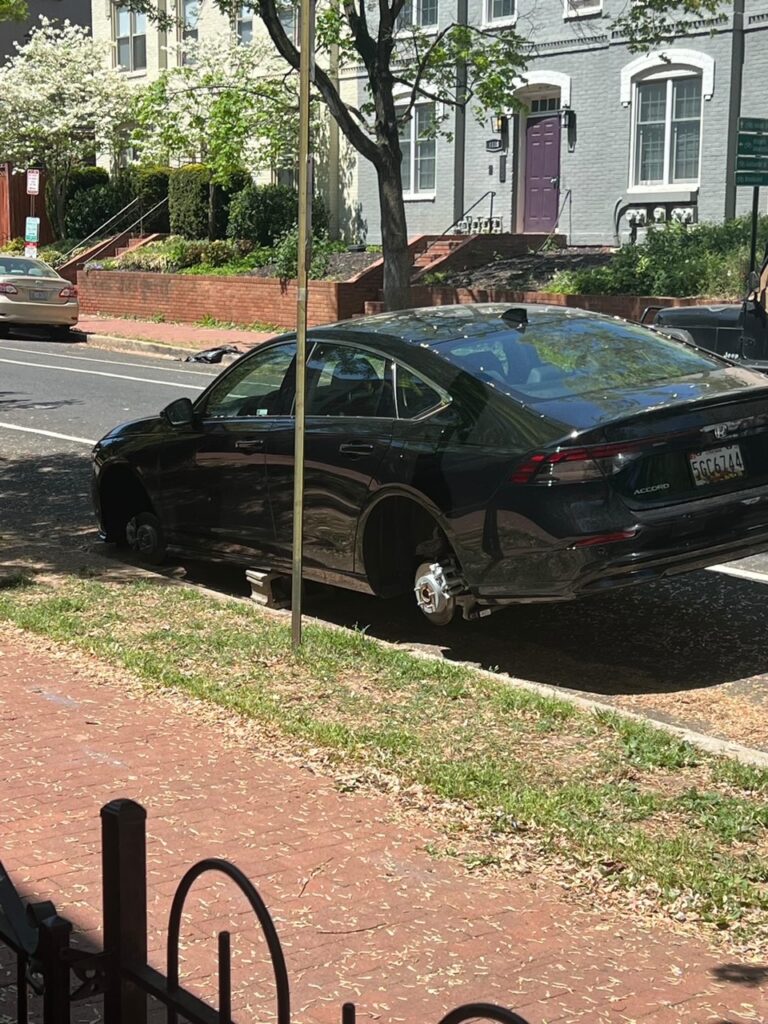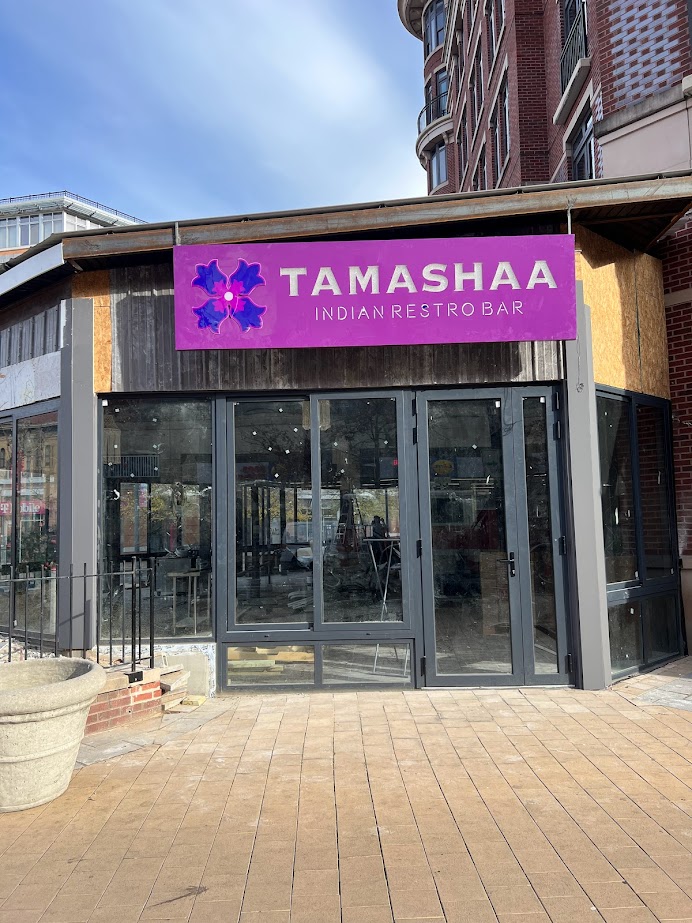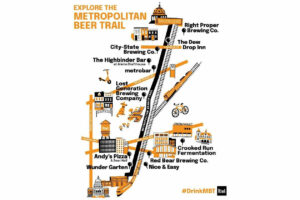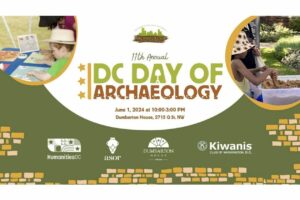Streets of Washington, written by John DeFerrari, covers some of DC’s most interesting buildings and history. John is the author of Historic Restaurants of Washington, D.C.: Capital Eats, published by the History Press, Inc. and also the author of Lost Washington DC.
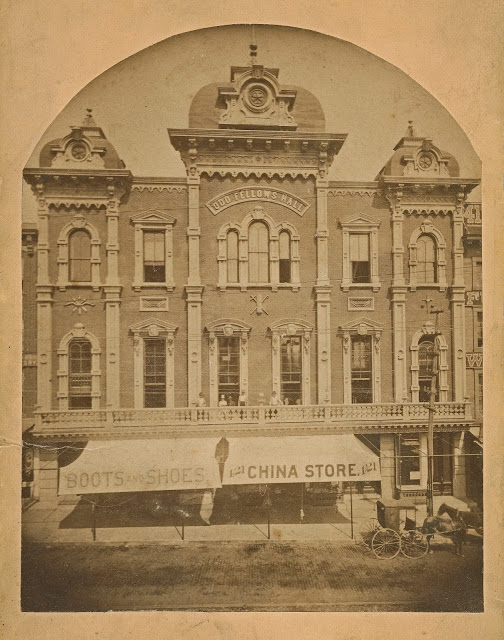
The Odd Fellows Hall, circa 1880. The two ground floor tenants are Asa U. Hazelton’s Boot and Shoe store on the left and the Webb & Beveridge China and Glass store on the right (author’s collection).
The Independent Order of Odd Fellows Temple, standing at 419 Seventh Street NW downtown, represents the rare persistence of a private organization at the same D.C. address for more than 170 years. The IOOF built their first hall at this location in 1845; today they still hold meetings here in the building they completed in 1917. Their previous hall, an ornate Victorian palace, was the scene of many social activities in the late 19th century but has rarely been captured in photographs.
The Odd Fellows are a benevolent fraternal society devoted to charitable works. The group began in England as “an organization of mechanics and laboring men, united for social purposes and to aid its members to obtain employment, as well as to assist them pecuniarily, when in need,” according to the group’s 1888 history. Like the Masons, the Odd Fellows were known for secret rituals, colorful uniforms and insignia, and elaborate ranks and degrees. The first American Odd Fellows lodge was founded by Thomas Wildey (1782-1861), a London blacksmith who came to America in 1817, in Baltimore in 1819. Odd Fellow lodges spread steadily throughout the United States after that, with over one hundred established by the 1830s. The first Washington, D.C., lodge was formed in 1827, and a Grand Lodge for the District of Columbia was established the following year. At least half a dozen separate lodges were formed throughout the District in the first half of the 19th century.
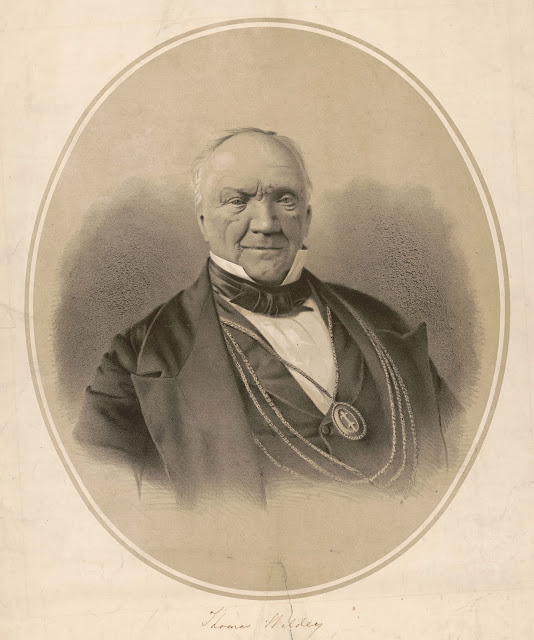
Thomas Wildey (Source: Library of Congress).
Work on the Odd Fellows’ large meeting hall on Seventh Street began in 1845. “The exterior of this edifice will present an appearance grand and imposing, highly ornamental, and a valuable acquisition to the popular part of the city where it will be located,” the Daily National Intelligencer observed in March 1845. The Classical Revival building featured a granite façade on the first floor, with pressed brick for the two floors above. The street level space was designed to be rented out for retail stores, while the second floor featured a large meeting room (called a saloon), measuring 42 by 70 feet with no obstructions and a 20-foot high ceiling. A separate area was set aside for an orchestra, making it one of the young city’s premiere event spaces. The third floor was reserved for IOOF activities.
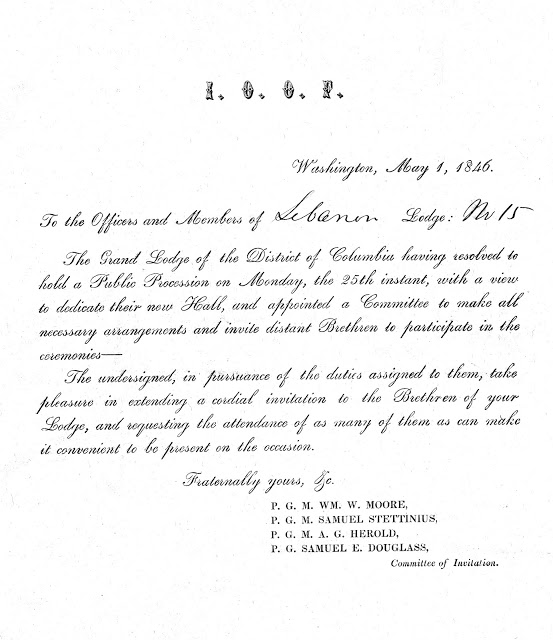
An invitation extended to an Odd Fellows Lodge in Ohio to attend the dedication of the new Hall on Seventh Street in May 1846 (author’s collection).
The National Intelligencer was pleased that the Odd Fellows had entrusted the construction work to William Goot Deale (1801-1868), “one of our worthy, experienced, and skillful mechanics.” The newspaper concluded that “this Hall will be one of the most substantial, convenient, and elegant superstructures ever erected in this country.” The completed building was dedicated in a festive ceremony on May 25, 1846, with Thomas Wildey in attendance from Baltimore.
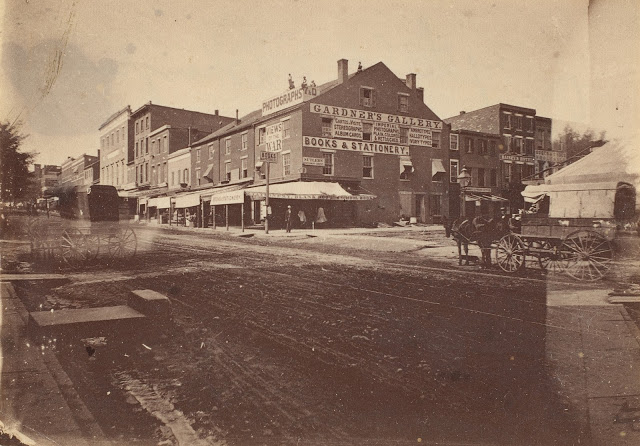
This photo of Gardner’s photographic gallery at 7th and D Streets NW gives a glimpse of the original Odd Fellows Hall. It is the tallest building along 7th Street to the left of Gardner’s, with a large white band below the cornice. (Source; The Metropolitan Museum of Art).
Washington City in the nineteenth century featured a variety of downtown venues for public performances and gatherings. In addition to theaters such as Ford’s, Grover’s, the American, and the National, public events were also regularly hosted at meeting halls such as the Odd Fellows Hall. Other such meeting spaces included Jackson Hall, Canterbury Hall, Lincoln Hall (profiled here), and the Masonic Temple, (profiled here). Performances also took place at private facilities such as Carusi’s Saloon and Metzerott’s Hall [An excellent article on Metzerott’s appears in the Fall 2016 issue of Washington History Magazine.]
The Odd Fellows Hall “for many years was regarded as the largest, as it certainly was the most popular, public hall in the District,” The Evening Star observed many years later. The events it hosted offer a fascinating glimpse into mid 19th century entertainment. Celebrated comedian George H. “Yankee” Hill appeared at the hall in July 1846, shortly after it opened, playing his stereotypical fast-talking Yankee character. Endless balls, concerts, and fancy dinners were held, one more elegant and refined than the other. Dancers at the ball of the Washington Light Infantry held on a Monday night in November 1848 “kept in continual motion, enjoying themselves in the mazy dance, until Tuesday morning almost at day-break.” Beyond live performances, art shows also made frequent appearances, including an exhibit of statuary in June 1848 and “Latum’s Great Scriptural Paintings” a year later. Crowds showed up in November 1848 to admire “Brewer’s panoramic views of Niagara Falls, Mammoth Cave, Natural Bridge, etc.,” said to be “wonderfully true to nature.” Bayne’s “Voyage to Europe” was an exhibit of paintings of London scenes that appeared late in 1849. Likewise Dr. E. Beale’s “New Panorama of Creation and Deluge” appeared in early 1853, wowing Washingtonians with its portrayal of “Thunder! Lightning! Storm! Deluge!”
Pushing the bounds of good taste, an advertisement appeared in early 1848 for “Dr. Collyer’s Model Artistes,” said to be “from the Royal Academies of Design of London and Paris.” The actors apparently posed as living tableaux of famous artworks: “The representations will consist of the choicest works of the Great Masters in Painting and Sculpture, including Powers’ celebrated statue of the GREEK SLAVE; and Persico’s Columbus and the Indian Girl.” The two sculptures, as every reader would have known, featured female nudes; how they were portrayed by the “artistes” at the Odd Fellows Hall is unknown but must have been at least mildly risqué. As if to assuage concerns about the tastefulness of the show, the National Intelligencer noted that “The Model Artistes now being exhibited at Odd Fellows’ Hall have attracted numerous and respectable companies on each successive night of their exhibition. We noticed several ladies in the room on Friday night, and we understand there were more in attendance on Saturday evening.”
On a more serious note, the hall was also used for civic meetings, including a spirited gathering of newspapermen in April 1848 who discussed the recent February revolution in France and expressed sympathy for what they perceived as a struggle of the common people. But underlying tensions between northerners and southerners in the U.S. seemed to have been on the minds of many attendees, even though the subject was ostensibly France. Someone cried out, “As suffrage has been extended to the people of France, I move that suffrage be extended to us!” The right to vote, even for white men, was not universal at the time, and that question implicitly underlined the deeper problem of slavery in America. The “excited proceedings” ended “in much confusion,” one Southern correspondent wrote.
The Hall continued to serve as a public venue throughout the Civil War years. Most events offered escape from the war’s anxieties—a ventriloquist named Wyman offered a “bottle, drum. and chair trick” as part of his act in November 1863, and “Signor Blitz” performed with his trained canaries in February 1865—but other performances were more patriotic. A painting “of the unnamed heroes” from a recent battle was part of an exhibit in July 1862 said to be “wonderful in its pathos.”
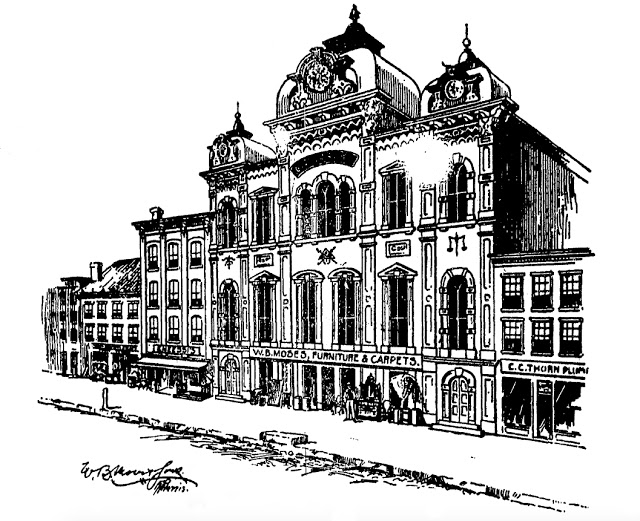
Drawing of the renovated Odd Fellows Hall from a 1926 advertisement for the W.B. Moses & Company furniture store. The Moses Company did briefly rent space in the Odd Fellows Hall, but that was in 1861, long before the renovations of 1872 depicted in this drawing. (Source: The Evening Star, March 7, 1926).
In 1872 the Odd Fellows decided to undertake a massive renovation that “will virtually make a new structure” of their hall, according to an article in The Evening Star. In addition to transforming the building’s façade with elaborate Second Empire style ornamentation, the renovations raised the second floor and extended it in the rear, significantly increasing the event space, and rearranged and expanded other rooms as well. Around the newly enlarged saloon “a handsome cornice will be run, and the walls will be frescoed in the very best style. There will be new and handsome gas fixtures, and, in fact, everything about the saloon will be new,” the Star promised.
Iron girders were installed to the support the increased floor space, and galvanized iron ornaments were added to the façade, including iron pilasters dividing it into five sections. Three towering mansarded domes crowned the impressive structure, and a grand balustrade spanned the second floor, allowing guests in the second-floor saloon to venture out on the balcony and take in the scene below them along busy Seventh Street. Builder Samuel Wise began construction after the iron girders arrived in May 1873; when it was completed is unclear; it was supposed to take five months.
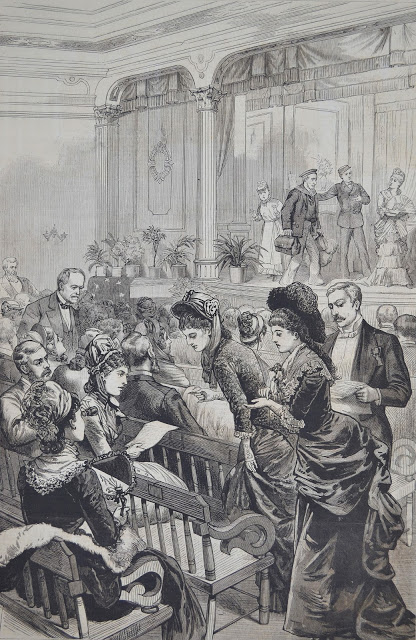
A drawing of the benefit for the Irish famine victims at the Odd Fellows Hall. Note General Sherman standing on the left. (Source: Frank Leslie’s Illustrated Newspaper, March 13, 1880).
Among the many events held in the rebuilt Odd Fellows Hall was a memorable evening of performances in February 1880 to raise money for the Irish suffering from the potato famine of 1879-1880. Organized “under the auspices of so many esteemed ladies of Washington,” the event attracted General of the Army William Tecumseh Sherman and Postmaster General David M. Key. “The hall was tastefully decorated, and thronged with the rank, fashion, and beauty of the capital,” according to Frank Leslie’s Illustrated Newspaper. The entertainment consisted of a series of amateur Irish-themed skits and songs, one of which, “Give Me Three Grains of Corn, Mother,” reportedly moved members of the audience, including General Sherman, to tears. With tickets selling at $1 apiece, the event pulled in $1,500 for Irish relief.
In 1917, the Odd Fellows decided to replace their venerable but outdated hall with an entirely new and modern structure. Designed by William S. Plager (1860-1946), a prolific local commercial and residential architect, the new building towered seven stories tall, dwarfing the other storefronts lining Seventh Street. The handsome, limestone-faced building features restrained, neoclassical detailing and a dormered mansard roof that harkens back to the building’s ornate predecessor.
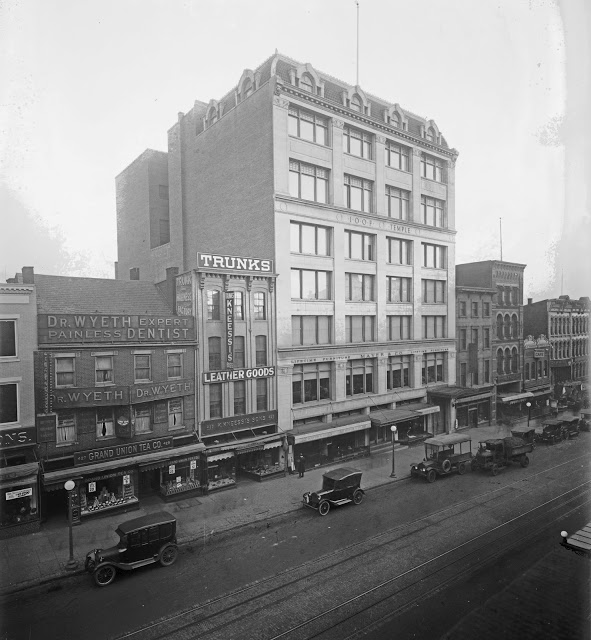
The new Odd Fellows Hall, circa 1921 (Source: Library of Congress).
With the cornerstone laid in June, construction was completed the following spring, and an opening ceremony was held in April 1918. The Odd Fellows had their meeting hall and offices on the top two floors of the building—as they still do to this day—while the lower floors were rented out for retail use. A cornice line above the fifth floor visually separates the Odd Fellows’ space from the commercial area below. The first tenant of the five lower floors and basement was the Mayer and Company furniture store, which since 1893 had occupied a smaller building next door. Mayer signed a ten-year lease at $190,000 per year (the building had cost $750,000 to build) and stayed on for many more years, finally leaving in 1967, five years after being absorbed into the W. and J. Sloane Company.
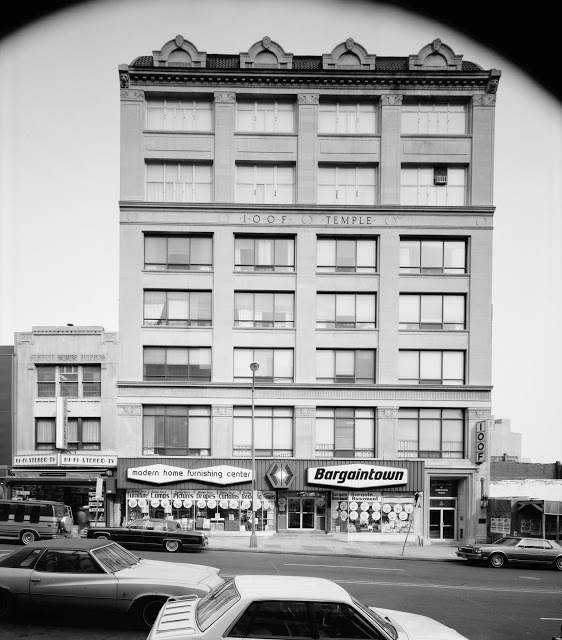
The Odd Fellows hall as photographed for the Historic American Buildings Survey in 1979.
The furniture company’s exit was symptomatic of the decline of the old downtown area that continued through the 1960s and 70s. While stores were shuttered all around it, the Odd Fellows remained in their hall, and, beginning in the 1980s redevelopment brought new life to the neighborhood. With the District Architecture Center now occupying the former Mayer and Company space, the stately building is as alive as ever, though its appearance on Seventh Street has changed little in its nearly 100-year history.
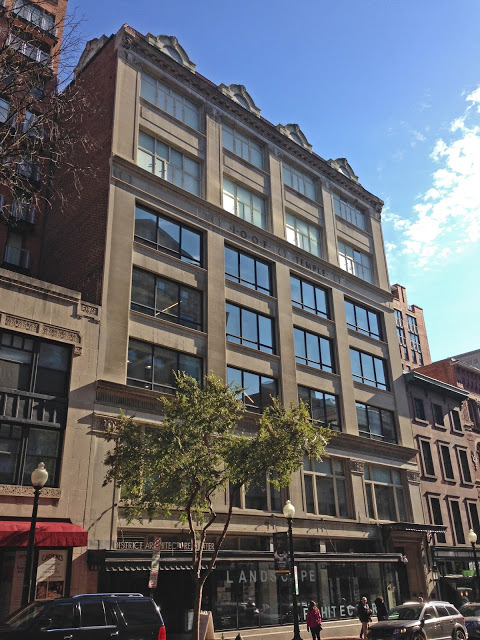
The Odd Fellows Hall as it appears today (photo by the author).
* * * * *
Special thanks to Ryan Shepard for his assistance. Other sources included James Goode, Capital Losses (2003); Independent Order of Odd Fellows Building, Historic American Buildings Survey (1979); Rev. R.R. Gurley, Morrison’s Stranger’s Guide for Washington City (1852); Casimer Bohn, Bohn’s Hand-Book of Washington (1856); John Clagett Proctor, Washington Past and Present: A History (1930); Theodore A. Ross, Odd Fellowship: Its History and Manual (1888); Washington, D.C. With Its Points of Interest Illustrated (1894); and numerous newspaper articles.
Recent Stories
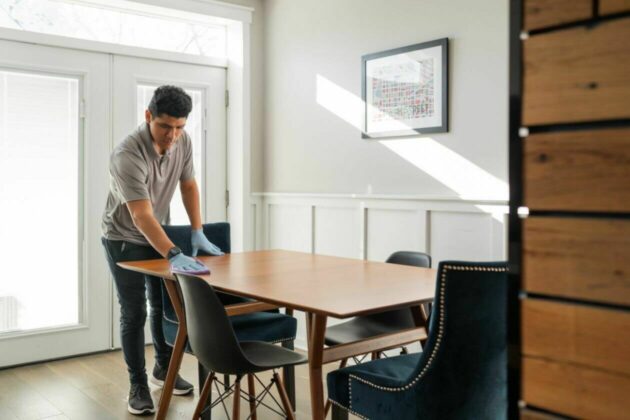
For many remote workers, a messy home is distracting.
You’re getting pulled into meetings, and your unread emails keep ticking up. But you can’t focus because pet hair tumbleweeds keep floating across the floor, your desk has a fine layer of dust and you keep your video off in meetings so no one sees the chaos behind you.
It’s no secret a dirty home is distracting and even adds stress to your life. And who has the energy to clean after work? That’s why it’s smart to enlist the help of professionals, like Well-Paid Maids.

Unlock Peace of Mind for Your Family! Join our FREE Estate Planning Webinar for Parents.
🗓️ Date: April 25, 2024
🕗 Time: 8:00 p.m.
Metropolitan Beer Trail Passport
The Metropolitan Beer Trail free passport links 11 of Washington, DC’s most popular local craft breweries and bars. Starting on April 27 – December 31, 2024, Metropolitan Beer Trail passport holders will earn 100 points when checking in at the
DC Day of Archaeology Festival
The annual DC Day of Archaeology Festival gathers archaeologists from Washington, DC, Maryland, and Virginia together to talk about our local history and heritage. Talk to archaeologists in person and learn more about archaeological science and the past of our


